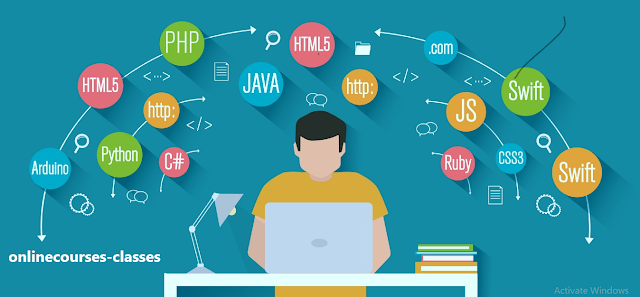programming language courses online
 |
| programming language courses online |
Introduction :
If you're looking to expand your programming skills and learn some new tools, this list of courses is for you. You'll get to work with the latest technologies, from Python and C++ to Git and Data Structures and Algorithms in C++.
Introduction to Programming
Programming is the process of writing computer programs. A programmer is someone who writes these programs.
The term "programming" comes from the Latin word "programmare," meaning to write in order or prepare. A programmer can be anyone with the necessary skills, but most people think of programmers as people who work on computers and make software that runs on them.
A computer is any device that stores data electronically through methods such as binary code (1s and 0s) or bits (binary digits). In its simplest form, a computer consists of just two basic parts: an input device (such as a keyboard) and an output device (the monitor). There are many different types of computers depending on what kind of processing power they have; however all modern computers use microchips for processing data at incredible speeds!
Introduction to Software Architecture
Software architecture is the design of a system. It's a way of designing, organizing and communicating how you want your software to work.
A software architecture is made up of components that are designed to solve a problem or support an objective (or both). A component is simply part of a larger software system and can be thought of as something like an object or class in object-oriented programming languages. Components can be simple or complex depending on their purpose, but they always have some kind of functionality related to solving problems for users or making decisions about what needs processing next so that it makes sense for users when you're developing them.
Architectures are designed so they will be flexible enough for future changes without breaking existing features or requiring major rewrites--and yet still maintain their integrity throughout their lifetime: this means thinking about how changes will affect existing code base as well as future iterations down the line!
Learning Git
Git is a distributed version control system that can be used to manage the development of software projects. Git was created by Linus Torvalds, who wanted a better way to keep track of his own code than manually keeping it in email messages.
The most basic use of Git is to create your own repository, where you store all the changes (or "commit") that you make over time. A commit may include one or more files, and these files could be related to each other in some way; for example, maybe they were all changed together at once or before/after another file was added/removed etc..
Git provides two ways for working with changes: "staging" and "releasing". Staging lets us save our local copy until we're ready to release it as an actual release (which means releasing could take place either locally or remotely).
Programming with Python
Python is a general-purpose programming language that's easy to learn and use. It has been used in many different industries, including finance, science and technology, and entertainment--and it's popular with both beginners and experts alike.
Python is well suited for data analysis, web development, and system administration. For example:
Data scientists can use Python to organize data into useful structures (such as tables), perform statistical analyses on their data sets without having any special knowledge of how those analyses are done (e.g., linear regression), visualize results using graphs or charts easily integrated into reports;
Web developers may prefer Python because it lets them focus more on creating beautiful user interfaces than writing code itself--and there are plenty of great frameworks available for building websites using Python ;
Object-Oriented Development using C++
Object-oriented programming (OOP) is a programming paradigm that encourages the creation of software by decomposing it into autonomous elements called objects. These objects can be manipulated through their attributes and behaviors.
In C++, object-oriented programming refers to the use of classes, which are templates for creating new types from existing ones and allowing you to create your own class hierarchies. You can write code using these concepts without needing to know anything about them!
Advanced Data Structures & Algorithms in C++
C++ is a general-purpose programming language that's used for both high-level and low-level programs. It's also very easy to read and write. C++ compiles into an executable machine code program, making it fast at run time.
C++ has its roots in Ada, which was originally developed as part of the NASA space station project in the 1970s by Digital Equipment Corporation (DEC). After DEC's bankruptcy in 1998, it was acquired by Microsoft and renamed "Visual Basic" before being repurposed again as a general purpose programming language called Microsoft Visual C++ -later known simply as Visual Studio Code (VS Code), which supports Linux distributions too!
Courses
Courses. Online courses are available for free, and they can be taken at your own pace. Some courses are offered in the form of videos or audio recordings that you must listen to before you can take the test. Other courses have interactive exercises where you get feedback on your answers as well as receive detailed explanations of concepts that are difficult for students with no background in the subject matter.
Conclusion
If you're looking to learn programming, we've got the courses for you. We've compiled a list of the best Python and C++ programs so that you can take your first steps into the world of computer science.